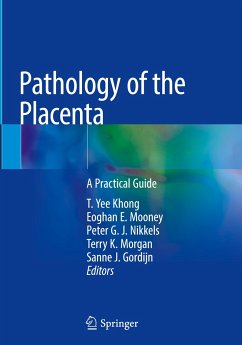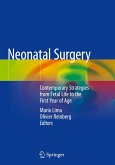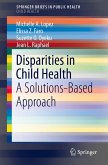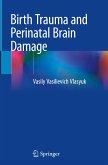Pathology of the Placenta
A Practical Guide
Herausgegeben:Khong, T. Yee; Mooney, Eoghan E.; Nikkels, Peter G. J.; Morgan, Terry K.; Gordijn, Sanne J.
Pathology of the Placenta
A Practical Guide
Herausgegeben:Khong, T. Yee; Mooney, Eoghan E.; Nikkels, Peter G. J.; Morgan, Terry K.; Gordijn, Sanne J.
- Gebundenes Buch
- Merkliste
- Auf die Merkliste
- Bewerten Bewerten
- Teilen
- Produkt teilen
- Produkterinnerung
- Produkterinnerung
This book provides a comprehensive resource on the pathology of the human singleton placenta. Agreed nomenclature, nosology, definitions and, where possible, thresholds for meaningful clinical corrections for lesions ideal for practical application in clinical practice are presented. Evidence is also featured on relevant potential clinical correlations to aid the reader in deciding upon the most appropriate management strategy. Areas of current uncertainty are also covered for potential future research.
Pathology of the Placenta systematically describes placental pathology, and represents a…mehr
![Practical Obstetrics Practical Obstetrics]() Joachim W. DudenhausenPractical Obstetrics114,99 €
Joachim W. DudenhausenPractical Obstetrics114,99 €![The Beginnings of Perinatal Medicine The Beginnings of Perinatal Medicine]() The Beginnings of Perinatal Medicine102,99 €
The Beginnings of Perinatal Medicine102,99 €![Neonatal Surgery Neonatal Surgery]() Neonatal Surgery170,99 €
Neonatal Surgery170,99 €![Palliativversorgung und Trauerbegleitung in der Neonatologie Palliativversorgung und Trauerbegleitung in der Neonatologie]() Palliativversorgung und Trauerbegleitung in der Neonatologie54,99 €
Palliativversorgung und Trauerbegleitung in der Neonatologie54,99 €![Muttermilchernährung bei Frühgeborenen Muttermilchernährung bei Frühgeborenen]() Thomas KühnMuttermilchernährung bei Frühgeborenen39,80 €
Thomas KühnMuttermilchernährung bei Frühgeborenen39,80 €![Disparities in Child Health Disparities in Child Health]() Michelle A. LopezDisparities in Child Health41,99 €
Michelle A. LopezDisparities in Child Health41,99 €![Birth Trauma and Perinatal Brain Damage Birth Trauma and Perinatal Brain Damage]() Vasily Vasilievich VlasyukBirth Trauma and Perinatal Brain Damage75,99 €
Vasily Vasilievich VlasyukBirth Trauma and Perinatal Brain Damage75,99 €-
-
-
Pathology of the Placenta systematically describes placental pathology, and represents a valuable resource for practising and trainee pathologists, obstetricians, neonatologists and epidemiologists.
- Produktdetails
- Verlag: Springer / Springer International Publishing / Springer, Berlin
- Artikelnr. des Verlages: 978-3-319-97213-8
- 1st ed. 2019
- Erscheinungstermin: Dezember 2018
- Englisch
- Abmessung: 260mm x 183mm x 27mm
- Gewicht: 1093g
- ISBN-13: 9783319972138
- ISBN-10: 3319972138
- Artikelnr.: 53015941
- Verlag: Springer / Springer International Publishing / Springer, Berlin
- Artikelnr. des Verlages: 978-3-319-97213-8
- 1st ed. 2019
- Erscheinungstermin: Dezember 2018
- Englisch
- Abmessung: 260mm x 183mm x 27mm
- Gewicht: 1093g
- ISBN-13: 9783319972138
- ISBN-10: 3319972138
- Artikelnr.: 53015941
Chapter 1. Introduction. An approach to placental pathology
Chapter 2. Placental Development with Expected Normal Gross and Microscopic Findings
Chapter 3. Indications for examining the placenta
Section 2. Gross examination
Chapter 4. Gross examination
Chapter 5. Placental Weight, Shape, and Gross Vascular Morphology
Section 3. Placental disc: Macroscopically Visible Lesions
Chapter 6. Infarction
Chapter 7. Intervillous thrombosis
Chapter 8. Massive perivillous fibrin deposition, maternal floor infarct
Chapter 9. Retroplacental haemorrhage, marginal haemorrhage
Chapter 10. Fetal Vascular Thrombosis
Chapter 11. Extravillous trophoblast cyst
Section 4. Placental disc: Microscopic Lesions
Chapter 12. Acute Chorioamnionitis
Chapter 13. Chorionic plate chronic inflammatory lesions including eosinophilic/T-cell chorionic vasculitis
Chapter 14. Maturity anomalies
Chapter 15. Distal villous hypoplasia
Chapter 16. Placental mesenchymal dysplasia
Chapter 17. Increased syncytial knot formation
Chapter 18. Persistence of cytotrophoblast
Chapter 19. Mineralization of trophoblast basement membrane
Chapter 20. Trophoblast and stroma: vacuolation - inherited disorder of metabolism
Chapter 21. Villous oedema
Chapter 22. Extramedullary haemopoiesis
Chapter 23. Intravillous haemorrhage
Chapter 24. Hypervascularity
Chapter 25. Fetal vascular malperfusion
Chapter 26. Presence of nucleated red blood cells
Chapter 27. Fetal vessels: malignancy
Chapter 28. Acute villitis
Chapter 29. Chronic villitis
Chapter 30. Chronic histiocytic intervillositis
Chapter 31. Intervillous space: infiltrates
Chapter 32. Pregnancy-induced uterine vascular remodelling and the pathophysiology of decidual vasculopathy
Chapter 33. Chronic deciduitis
Chapter 34. Basal plate myometrial fibres
Chapter 35. Basal plate laminar necrosis
Chapter 36. Retroplacental Haematoma/Haemorrhage (RPH)
Chapter 37. Miscellaneous Lesions of the Villous Parenchyma
Section 5. Amniochorial membranes: Macroscopically Visible Lesions
Chapter 38. Amniochorial membrane nodules
Chapter 39. Placental changes in amniotic band sequence, extra-amniotic and extramembranous pregnancy
Section 6. Amniochorial membranes: Microscopic Lesions
Chapter 40. Amnion Transport: Histologic Features
Chapter 41. Choriodecidual haemosiderin staining
Chapter 42. Laminar necrosis; membrane chorionic microcysts and chorion nodosum
Chapter 43. Decidual Vasculopathy
Chapter 44. Acute inflammation
Chapter 45. Chronic inflammation
Section 7. Umbilical cord
Chapter 46. Umbilical Cord Length
Chapter 47. Umbilical Cord coiling
Chapter 48. Cord knots and pseudo-knots
Chapter 49. Umbilical cord tumours
Chapter 50. Umbilical Cord Insertion abnormalities
Chapter 51. Embryonic remnants and pathology
Chapter 52. Single Umbilical Artery, Supernumerary Vessels, Segmental Thinning of the Umbilical Cord Vessels and Vascular calcifications in umbilical vessels
Chapter 53. Umbilical cord ulcer
Chapter 54. Umbilical vascular myonecrosis
Chapter 55. Inflammation
Section 8. Clinical correlation, reporting and frontiers
Chapter 56. Constellations of Pathology in the Placenta and How They Relate to Clinical Conditions.
Chapter 57. The Placental Pathology Report
Chapter 58. Frontiers
Chapter 1. Introduction. An approach to placental pathology
Chapter 2. Placental Development with Expected Normal Gross and Microscopic Findings
Chapter 3. Indications for examining the placenta
Section 2. Gross examination
Chapter 4. Gross examination
Chapter 5. Placental Weight, Shape, and Gross Vascular Morphology
Section 3. Placental disc: Macroscopically Visible Lesions
Chapter 6. Infarction
Chapter 7. Intervillous thrombosis
Chapter 8. Massive perivillous fibrin deposition, maternal floor infarct
Chapter 9. Retroplacental haemorrhage, marginal haemorrhage
Chapter 10. Fetal Vascular Thrombosis
Chapter 11. Extravillous trophoblast cyst
Section 4. Placental disc: Microscopic Lesions
Chapter 12. Acute Chorioamnionitis
Chapter 13. Chorionic plate chronic inflammatory lesions including eosinophilic/T-cell chorionic vasculitis
Chapter 14. Maturity anomalies
Chapter 15. Distal villous hypoplasia
Chapter 16. Placental mesenchymal dysplasia
Chapter 17. Increased syncytial knot formation
Chapter 18. Persistence of cytotrophoblast
Chapter 19. Mineralization of trophoblast basement membrane
Chapter 20. Trophoblast and stroma: vacuolation - inherited disorder of metabolism
Chapter 21. Villous oedema
Chapter 22. Extramedullary haemopoiesis
Chapter 23. Intravillous haemorrhage
Chapter 24. Hypervascularity
Chapter 25. Fetal vascular malperfusion
Chapter 26. Presence of nucleated red blood cells
Chapter 27. Fetal vessels: malignancy
Chapter 28. Acute villitis
Chapter 29. Chronic villitis
Chapter 30. Chronic histiocytic intervillositis
Chapter 31. Intervillous space: infiltrates
Chapter 32. Pregnancy-induced uterine vascular remodelling and the pathophysiology of decidual vasculopathy
Chapter 33. Chronic deciduitis
Chapter 34. Basal plate myometrial fibres
Chapter 35. Basal plate laminar necrosis
Chapter 36. Retroplacental Haematoma/Haemorrhage (RPH)
Chapter 37. Miscellaneous Lesions of the Villous Parenchyma
Section 5. Amniochorial membranes: Macroscopically Visible Lesions
Chapter 38. Amniochorial membrane nodules
Chapter 39. Placental changes in amniotic band sequence, extra-amniotic and extramembranous pregnancy
Section 6. Amniochorial membranes: Microscopic Lesions
Chapter 40. Amnion Transport: Histologic Features
Chapter 41. Choriodecidual haemosiderin staining
Chapter 42. Laminar necrosis; membrane chorionic microcysts and chorion nodosum
Chapter 43. Decidual Vasculopathy
Chapter 44. Acute inflammation
Chapter 45. Chronic inflammation
Section 7. Umbilical cord
Chapter 46. Umbilical Cord Length
Chapter 47. Umbilical Cord coiling
Chapter 48. Cord knots and pseudo-knots
Chapter 49. Umbilical cord tumours
Chapter 50. Umbilical Cord Insertion abnormalities
Chapter 51. Embryonic remnants and pathology
Chapter 52. Single Umbilical Artery, Supernumerary Vessels, Segmental Thinning of the Umbilical Cord Vessels and Vascular calcifications in umbilical vessels
Chapter 53. Umbilical cord ulcer
Chapter 54. Umbilical vascular myonecrosis
Chapter 55. Inflammation
Section 8. Clinical correlation, reporting and frontiers
Chapter 56. Constellations of Pathology in the Placenta and How They Relate to Clinical Conditions.
Chapter 57. The Placental Pathology Report
Chapter 58. Frontiers








